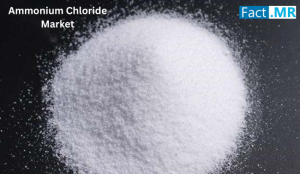Ammonium Chloride Market to Hit US$ 2.4 Billion by 2035, Driven by Growth in Agriculture, Industrial & Pharma Sectors
Ammonium chloride market set for strong growth, driven by increasing demand in agriculture, industrial processes, and pharmaceutical applications.
ROCKVILLE, MD, UNITED STATES, August 6, 2025 /EINPresswire.com/ -- The global ammonium chloride market is gearing up for transformative growth, forecasted to rise from USD 1.6 billion in 2025 to USD 2.4 billion by 2035, at a steady CAGR of 4.1%.This growth trajectory is anchored by a powerful confluence of factors—expanding agricultural needs, a rise in industrial applications, and evolving pharmaceutical innovations. For global manufacturers and supply chain stakeholders, this signals a pivotal moment to align strategies, adopt cleaner technologies, and respond to emerging demand trends.Feeding the Future: Agriculture Leads the Charge
The world’s food security challenges are mounting as the global population heads toward 9.8 billion by 2050, and agricultural land becomes increasingly constrained. Ammonium chloride, a vital nitrogen-rich fertilizer, is becoming indispensable to crop productivity, particularly in regions with alkaline soils.
Asia remains at the forefront of this growth. With vast rice and wheat cultivation zones, China and India are ramping up domestic production and infrastructure investments to ensure reliable ammonium chloride availability. As precision agriculture and government-backed soil fertility initiatives gain traction, manufacturers have a unique opportunity to provide advanced fertilizer blends and contribute to sustainable farming.
Public investments across emerging markets like Nigeria and Southeast Asia are further driving ammonium chloride adoption, especially for staple crops. Manufacturers and investors targeting this sector can expect a stable demand foundation and long-term relevance.
Beyond the Field: Industrial and Pharmaceutical Demand Takes Center Stage
Ammonium chloride plays a vital role beyond agriculture, finding key uses in metalworking, textiles, and pharmaceuticals. Germany drives demand through industrial applications and clean production standards, while China dominates global output with cost-effective, integrated manufacturing. In pharma, it’s essential for cough medications and IV treatments, with rising demand in affordable healthcare markets.
A Regional Overview: Opportunity Meets Complexity
North America: Stable agricultural demand, evolving sustainability goals, and well-developed industrial infrastructure create a mature yet innovation-driven market. The focus is on eco-friendly production methods and supply chain optimization.
Europe: Regulatory compliance, especially under REACH, shapes the market. France is adopting ammonium chloride for chloride-deficient soil treatments, while Germany focuses on industrial purity and environmental compliance.
Asia-Pacific: The epicenter of both production and consumption, with China, India, and Japan dominating. Investments in smart agriculture, byproduct utilization, and advanced filtration systems are redefining the regional competitive edge.
LAMEA (Latin America, Middle East, and Africa): Rapid growth potential backed by agricultural expansion and infrastructure development. Despite economic and logistical challenges, countries are building local ammonium chloride facilities to reduce import dependency.
Challenges in Focus: Price, Regulation, and Competition
While the ammonium chloride market outlook is promising, manufacturers must navigate a complex landscape:
Raw material volatility—prices for ammonia and hydrochloric acid are prone to fluctuation, affecting margins.
Environmental concerns—production byproducts pose pollution risks, especially in countries with strict emissions controls.
Worker safety protocols—handling ammonium chloride requires rigorous standards to avoid respiratory and chemical exposure.
Substitute competition—widespread use of urea and ammonium sulfate in fertilizer blends can shift market share unless ammonium chloride is better integrated into modern formulations.
For market participants, this means future growth is contingent on cost management, R&D investments, and transparent regulatory compliance.
Segment Highlights: Industrial Grade and Fertilizers Lead Growth
Industrial-grade ammonium chloride is dominating the market due to its wide applicability in metal treatment, chemical manufacturing, and textiles. Its purity and consistency make it a go-to compound for high-precision industries.
Fertilizers continue to be the leading application segment, particularly in Asian agriculture. With rising soil nutrient depletion, ammonium chloride remains essential for photosynthesis enhancement and soil balancing.
Food-grade ammonium chloride, though a niche segment, is witnessing the fastest growth, driven by demand in pharmaceuticals and food processing, where safety and purity are non-negotiable.
Metalworking is the fastest-growing application beyond agriculture, as ammonium chloride enables clean, oxide-free bonding for automotive and electronics manufacturing.
Competitive Landscape: Strategic Expansion and Tech-Driven Efficiency
The global ammonium chloride landscape is evolving. Key players such as Zaclon LLC, BASF SE, Liuzhou Chemical, GFS Chemicals, The Chemical Company, and Tuticorin Alkali are enhancing their production technologies to meet purity standards and environmental regulations.
China-based manufacturers dominate with low-cost output and integrated soda ash processes, enabling scalability and export competitiveness.
Recent expansions and partnerships reinforce this market momentum:
In March 2024, Actylis and Novo Nordisk Pharmatech A/S joined forces to distribute high-standard quaternary ammonium compounds across key European markets.
In January 2024, Southern Petrochemical Industries Corporation (SPIC) announced a ₹1,900 crore expansion to boost production and diversify operations, signaling confidence in long-term ammonium chloride demand.
Request Ammonium Chloride Market Draft Report - https://www.factmr.com/connectus/sample?flag=S&rep_id=947
For more on their methodology and market coverage, visit - https://www.factmr.com/about-company
The Road Ahead: Manufacturers Must Seize the Moment
As demand for ammonium chloride spans across sectors—from feeding populations to fortifying machines and healing patients—manufacturers, suppliers, and market stakeholders must focus on innovation, sustainability, and strategic localization.
Check out More Related Studies Published by Fact.MR:
Isomerized Olefins Market
https://www.factmr.com/report/2517/isomerized-olefins-market
Metal Halide Market
https://www.factmr.com/report/2523/metal-halide-market
Titanium Dioxide Pigment Market
https://www.factmr.com/report/2531/titanium-dioxide-pigment-market
Polyepoxysuccinic Acid Market
https://www.factmr.com/report/2953/polyepoxysuccinic-acid-market
Editor’s Note:
This release is based exclusively on verified and factual market content derived from industry analysis by FactMR. No AI-generated statistics or speculative data have been introduced. This story is designed to support manufacturers, healthcare providers, and wellness brands in recognizing the Ammonium Chloride industry as a major growth and innovation sector for the coming decade.
S. N. Jha
Fact.MR
+1 628-251-1583
sales@factmr.com
Legal Disclaimer:
EIN Presswire provides this news content "as is" without warranty of any kind. We do not accept any responsibility or liability for the accuracy, content, images, videos, licenses, completeness, legality, or reliability of the information contained in this article. If you have any complaints or copyright issues related to this article, kindly contact the author above.
Michelin-Trained Chef Reimagines Intimate Luxury Dining
Marisol Diaz Features on the Cover of Ejecutiva Magazine
The Tax Business Summit — A Game-Changer for Tax Pros, Business Owners and Entrepreneurs
Więcej ważnych informacji
 Jedynka Newserii
Jedynka Newserii

 Jedynka Newserii
Jedynka Newserii

Handel

Mercosur to tylko wierzchołek góry lodowej. UE ma ponad 40 umów handlowych, które mogą destabilizować rynek rolny
Umowa handlowa między UE a krajami Mercosur może znacząco zaburzyć konkurencję na rynku rolnym i osłabić pozycję unijnych, w tym polskich, producentów – ostrzegają rolnicy i producenci żywności. Umowie sprzeciwia się część krajów unijnych, które domagają się klauzuli ochronnych oraz limitów importowych. – Problemem jest jednak nie tylko ta konkretna umowa. Chodzi o cały system wolnego handlu, który się kumuluje z dziesiątek innych porozumień – podkreśla Andrzej Gantner, wiceprezes Polskiej Federacji Producentów Żywności.
Firma
Dzięki zdalnej weryfikacji tożsamości z wykorzystaniem AI firmy zminimalizowały liczbę oszustw. Rozwiązania wykorzystuje głównie sektor finansowy

Z najnowszych danych Eurostatu wynika, że w 2024 roku 5,9 proc. polskich firm korzystało z rozwiązań z zakresu sztucznej inteligencji. W 2023 roku był to odsetek na poziomie 3,67 proc. Wciąż jednak jest to wynik poniżej średniej unijnej, która wyniosła 13,48 proc. Jednym z obszarów, który cieszy się coraz większym zainteresowaniem wśród przedsiębiorców, jest weryfikacja tożsamości przez AI, zwłaszcza w takich branżach jak bankowość, ubezpieczenia czy turystyka. Jej zastosowanie ma na celu głównie przeciwdziałać oszustwom i spełniać wymogi regulacyjne.
Prawo
Daniel Obajtek: Własne wydobycie i operacyjne magazyny to filary bezpieczeństwa. Zgoda na magazyny gazu poza krajem to rezygnacja z suwerenności energetycznej

Były prezes Orlenu ostrzega przed zmianami w ustawie o zapasach ropy naftowej, produktów naftowych i gazu ziemnego. Jego zdaniem przygotowana przez rząd nowelizacja tzw. ustawy magazynowej i ujednolicanie unijnej polityki energetycznej to zagrożenie dla bezpieczeństwa energetycznego Polski. W jego opinii tylko silna spółka narodowa, własne wydobycie, krajowe magazyny i zbilansowany miks energetyczny zapewnią Polsce bezpieczeństwo i konkurencyjność.
Partner serwisu
Szkolenia

Akademia Newserii
Akademia Newserii to projekt, w ramach którego najlepsi polscy dziennikarze biznesowi, giełdowi oraz lifestylowi, a także szkoleniowcy z wieloletnim doświadczeniem dzielą się swoją wiedzą nt. pracy z mediami.





![Nestlé w Polsce podsumowuje wpływ na krajową gospodarkę. Firma wygenerowała 0,6 proc. polskiego PKB [DEPESZA]](https://www.newseria.pl/files/1097841585/fabryka-nesquik_1,w_85,r_png,_small.png)



.gif)

 |
| |
| |
|